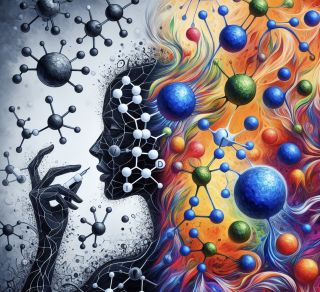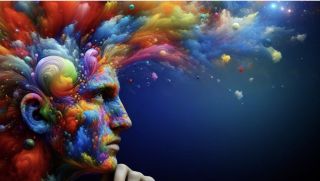Creativity
Enhancing Creativity With Psychedelics
How psychedelic medicines can be used to inspire us.
Posted April 15, 2024 Reviewed by Devon Frye
Key points
- Psychedelic medicines are natural and synthetic substances that alter consciousness.
- Numerous scientific studies have demonstrated that psychedelics enhance creativity and performance.
- Psychedelic medicines stimulate the growth of new nerve cells and new connections between nerve cells.

This post is coauthored by Courtney Olson.
Psychedelic medicines are natural and synthetic substances that share a unique ability to produce alteration in consciousness. Examples of psychedelics include psilocybin mushrooms, peyote cactus, the Amazonian tea ayahuasca, and lysergic acid diethylamide (LSD).
In the United States, the Drug Enforcement Administration classifies psychedelic medicines as Schedule I drugs, which means they currently have no approved medicinal use and a high abuse potential. However, proponents hope this will change if further scientific research can demonstrate their safe use and therapeutic benefits.
Indigenous cultures have utilized psychedelic medicines safely for millennia, employing them for healing, divination, and personal growth. More recently, non-indigenous healthcare practitioners have begun exploring these medicines as potential treatments for a wide variety of psychiatric disorders including depression, anxiety, posttraumatic stress disorders, obsessive-compulsive disorder, and substance use disorders. In addition to improving mental health, psychedelic medicines have also been discovered to enhance creativity.
What is Creativity?
Creativity is described as the creation of ideas or objects considered both novel and valuable. Features of creativity include divergent thinking, convergent thinking, generating unusual ideas, problem-solving, and designing new devices.
Divergent thinking involves the ability to develop multiple, alternative solutions to a single question or problem. Convergent thinking, on the other hand, relates to finding a single answer to a question or problem.

Psychedelics Enhance Creativity
Multiple psychedelic medicines have been found to enhance creativity. Researchers from the Netherlands, Spain, and the United States collaborated on a study exploring ayahuasca’s effects on creativity. They found this Amazonian brew enhances divergent thinking. A follow-up study conducted two years later found a single dose of ayahuasca improved convergent thinking for as long as four weeks after ingestion.
Another study conducted by researchers from the Netherlands, the United Kingdom, and Germany explored psilocybin’s effects on creativity. They found this medicine increased creative thinking. And dating back more than 50 years, studies investigating LSD’s effects on creativity have also demonstrated positive effects.
Who Uses Psychedelics to Enhance Creativity?
The diversity of individuals who attribute their success to the use of psychedelics is remarkable. They include Nobel laureate Francis Crick who claimed in the Mail on Sunday that he was under the influence of LSD when he discovered the structure of DNA. Kary Mullis is another Nobel Prize winner who utilized LSD. In his book Dancing Naked in the Mine Field, Mullis credits his discovery of the polymerase chain reaction (PCR) to his experiences with LSD.
An article in AP News reported that tech innovator Steve Jobs took LSD when he was young to spark his creativity. Later, Jobs described his use of LSD as one of the two or three most important things he did in his life. Numerous musicians, actors, comedians, artists, and authors also acknowledge utilizing psychedelics.
The benefits may even extend beyond our traditional ideas of creative pursuits, as numerous professional athletes also credit psychedelics with improving their performance. For example, Super Bowl MVP Aaron Rodgers stated at the Multidisciplinary Association for Psychedelic Studies conference in Denver, Colorado, in June 2023 that taking ayahuasca with his teammates was “radically life-changing.” Rodgers credits ayahuasca with improving his performance on the football field.
Another professional athlete who ascribed his success to psychedelics was pitcher Dock Ellis of the Pittsburgh Pirates. As reported in Sports Illustrated, Ellis threw a no-hitter on June 12, 1970, after ingesting LSD earlier that day.

How could these consciousness-altering medicines produce such wide-ranging benefits in such a diverse group of high achievers? The answer may result from these medicines’ two unique mechanisms of action. The first is their well-known ability to produce altered states of consciousness, and the second is their lesser-known ability to trigger neuroplastic changes in the brain.
How Do Psychedelics Enhance Creativity?
The alterations in consciousness produced by psychedelic medicines include perceptual changes, an altered sense of time, changes in one’s sense of self, an altered sense of meaning, and novel insights. The neuroplastic changes include the creation and remodeling of synaptic connections in the brain. Researcher David Olson at the University of California has coined a new term for medicines that induce neuroplastic changes in the brain. He calls them psychoplastogens.
Psychoplastogens produce neuroplastic changes by stimulating the release of a protein called brain-derived neurotrophic factor (BDNF). This protein triggers the growth of new neurons (i.e., neurogenesis) and new connections between neurons (i.e., synaptogenesis). Synaptogenesis and neurogenesis play a key role in learning and memory, which have been linked with creativity. Thus, not only do psychedelic medicines produce shifts in consciousness that facilitate novel perspectives and ideas, but they also stimulate the growth and reorganization of brain cells, which facilitates learning and memory.
Future Directions
As research continues to explore the effect of psychedelic medicines on creativity, one potential source of inspiration may be the plants themselves. In her book Thus Spoke the Plant, Associate Professor Monica Gagliano at Southern Cross University in Australia describes how her use of psychedelic plant medicines guided her to carry out studies examining the intelligence of plants. Gagliano went on to conduct groundbreaking research demonstrating that plants can sense their environment, communicate and share nutrients with other plants, perform simple mathematical computations, remember, and make decisions. Perhaps these plants have more to teach us.

Courtney Olson is a fourth-year medical student at the University of Colorado School of Medicine. She will be starting residency in June 2024 at Beth Israel Deaconess Medical Center—Harvard training in the Community Psychiatry Track.
References
Baggott MJ. Psychedelics and Creativity: a Review of the Quantitative Literature. PeerJ Preprints. 30 June 2015.
Gagliano, Monica. Thus Spoke the Plant: A Remarkable Journey of Groundbreaking Scientific Discoveries and Personal Encounters With Plants. North Atlantic Books, 2018.
Gandy, Sam, et al. Psychedelics as potential catalysts of scientific creativity and insight. Drug Science, Policy and Law 8 (2022): 20503245221097649.
Janiger, Oscar, and Marlene Dobkin De Rios. LSD and creativity. Journal of Psychoactive Drugs 21.1 (1989): 129–134.
Olson DE. Psychoplastogens: a promising class of plasticity-promoting neurotherapeutics. Journal of Experimental Neuroscience. 2018 Sep;12:1179069518800508.
Tupper KW et al. Psychedelic medicine: a re-emerging therapeutic paradigm. Cmaj. 2015 Oct 6;187(14):1054–1059.




